Table of Contents
Smart Bandages Statistics: The increasing prevalence of chronic wounds, diabetes, and obesity, along with the rising aging population, has boosted the demand for advanced wound care products.
These Smart bandages, with their ability to monitor wound conditions and deliver medications precisely, have emerged as a promising solution to these healthcare challenges.
Smart bandages, also known as intelligent or digital bandages, are an innovative advancement in wound care technology. Leveraging the power of data and real-time monitoring, these bandages have the potential to revolutionize wound care and treatment outcomes.

Key Smart Bandages Statistics
- The Wound Care Market size is expected to be worth around USD 30.2 Bn by 2032 from USD 18.4 Bn in 2022, growing at a CAGR of 5.2% during the forecast period from 2022 to 2032
- In 2022, the global market for smart bandages was estimated at $1.5 billion. Driven by technological advancements and growing demand for advanced wound care, the market is expected to reach $2.9 billion by 2027, registering a CAGR of 14.1%.
- North America Dominated the global smart bandages market with the largest market share of 43% in 2022.
- Major players in the smart bandages industry include names like 3M, Medtronic, Smith & Nephew, and others.
- Smart bandages have high demand in chronic wound management and post-surgical care.
- The COVID-19 pandemic has significantly influenced the healthcare sector, accelerating the adoption of telehealth and remote patient monitoring systems, including smart bandages.
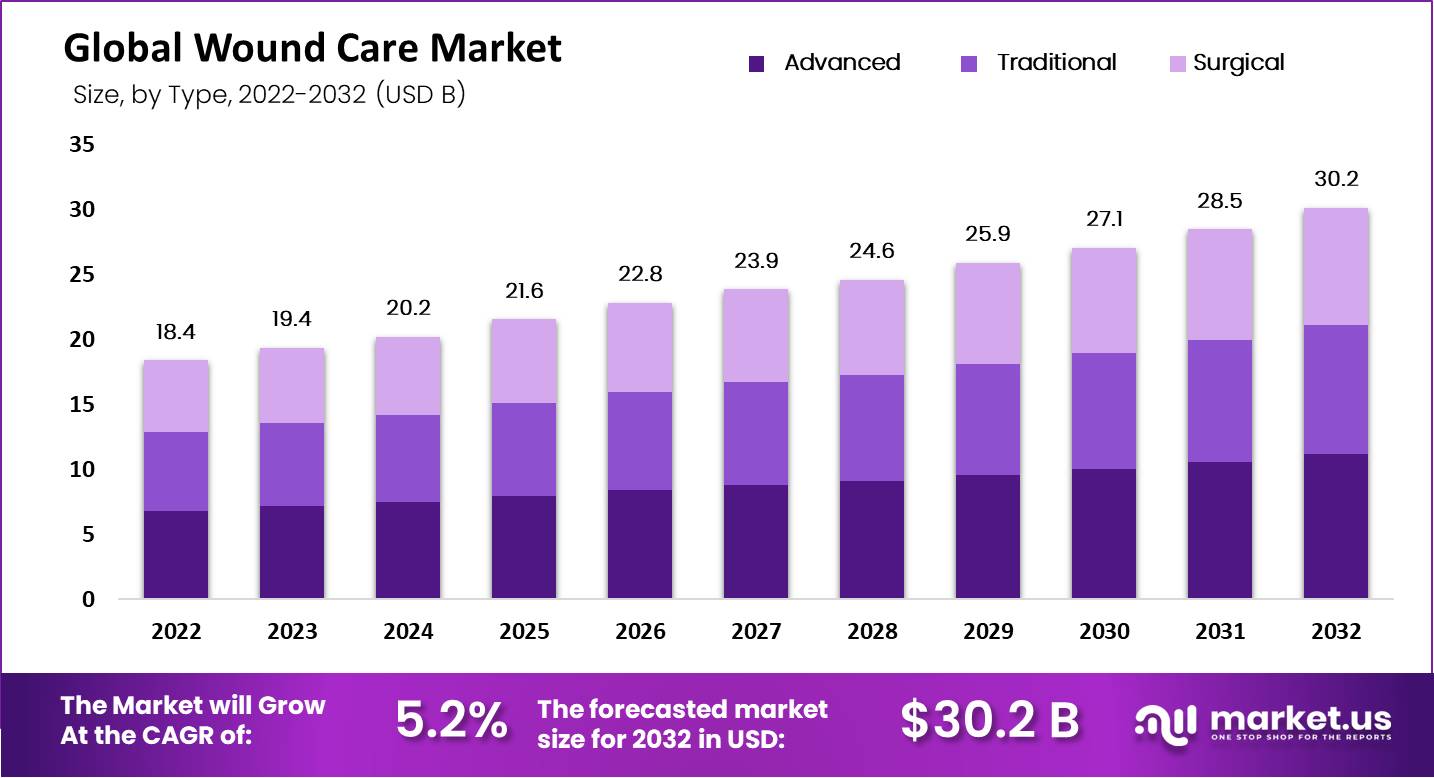
Smart Bandages Statistics – By Types
- Sensor-based Smart Bandages: These bandages contain sensors capable of monitoring various parameters at the wound site, including temperature, moisture level, pH levels, and pressure. Real-time data provided to healthcare providers allows them to track healing progress more closely and assess progress at regular intervals.
- Drug-Infused Smart Bandages: These bandages are specifically designed to deliver medication directly to wound sites. With integrated drug delivery systems that release therapeutic agents at regular intervals over an extended period, this type of bandage is particularly suitable for chronic wounds or infections needing localized treatment.
- Electroactive Smart Bandages: These bandages use electrical stimulation to accelerate wound healing. Their low-level electrical currents stimulate tissue regeneration and blood circulation near the wound site, hastening the healing process.
- Temperature-Sensitive Smart Bandages: These bandages contain thermoresponsive materials or indicators that change color based on the temperature of a wound, enabling healthcare providers to quickly detect any potential signs of infection or inflammation through visual inspection.
- pH-Sensing Smart Bandages: These bandages contain thermoresponsive materials or indicators that change color based on the temperature of a wound, enabling healthcare providers to quickly detect any potential signs of infection or inflammation through visual inspection.
- Oxygen-Sensing Smart Bandages: These bandages contain oxygen sensors to measure oxygen levels at the wound site. This feature makes them particularly effective at monitoring chronic wounds or post-surgical wounds where adequate oxygen supplies are essential to their successful healing.
User Preference for Different Types of Smart Bandages
According to a study by NIH,
- The electroactive smart bandages have high demand with a user percentage of around 25%.
- About 20% of users prefer sensor-based smart bandages for wound care followed by drug-infused, oxygen-sensing, and pH-sensing smart bandages with 15% each.
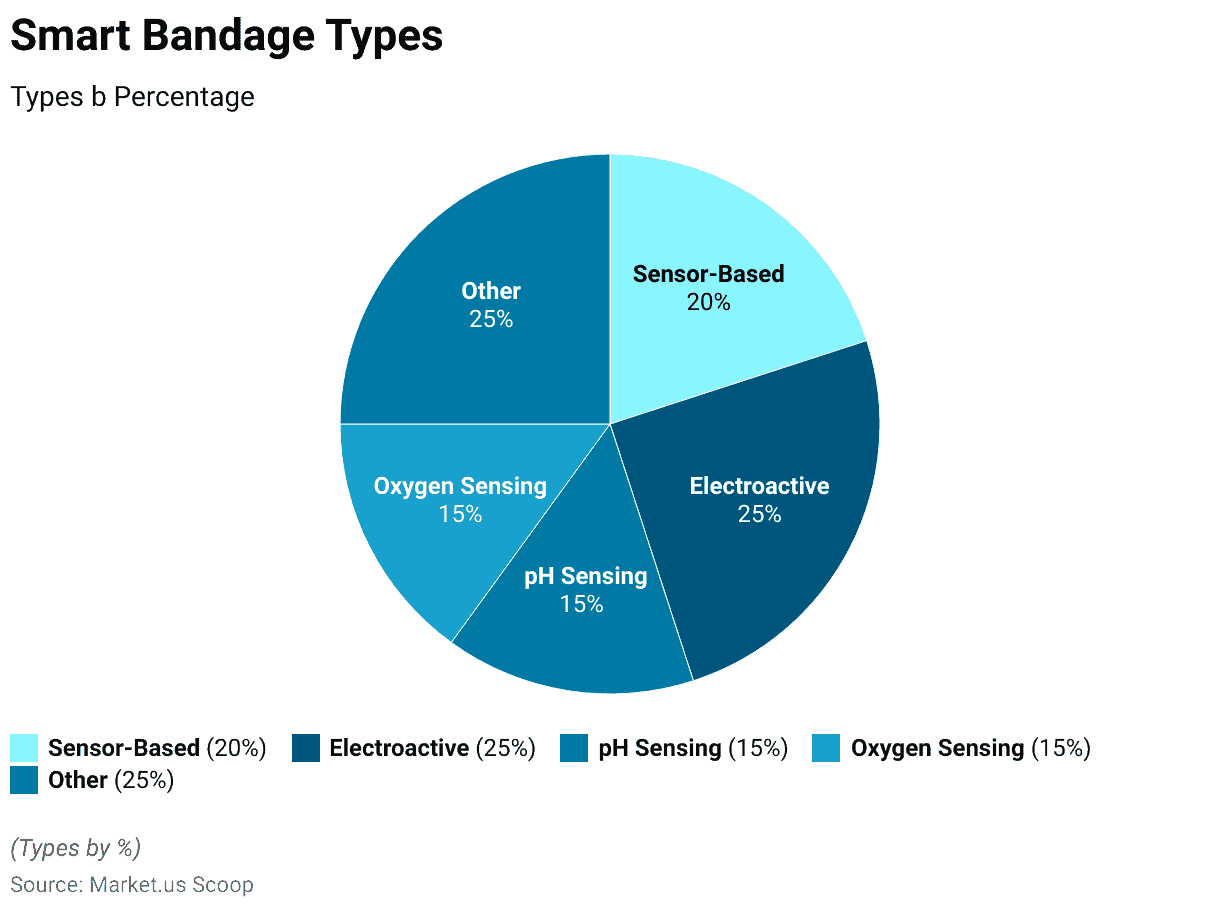
Smart Bandages Statistics Users by Age
- People aged 25-34 years are more likely to use smart bandages with 30%.
- About 20% of users aged 18-24 years use smart bandages for their wound care and chronic wound monitoring.
- 18% of people aged 45-54 years use smart bandages for their wound care followed by people aged 35-44 years with 15%.
- The use of smart bandages is comparatively less in people aged 55+ and under 18 with 7% and 10% respectively.
(Source: Caltech)
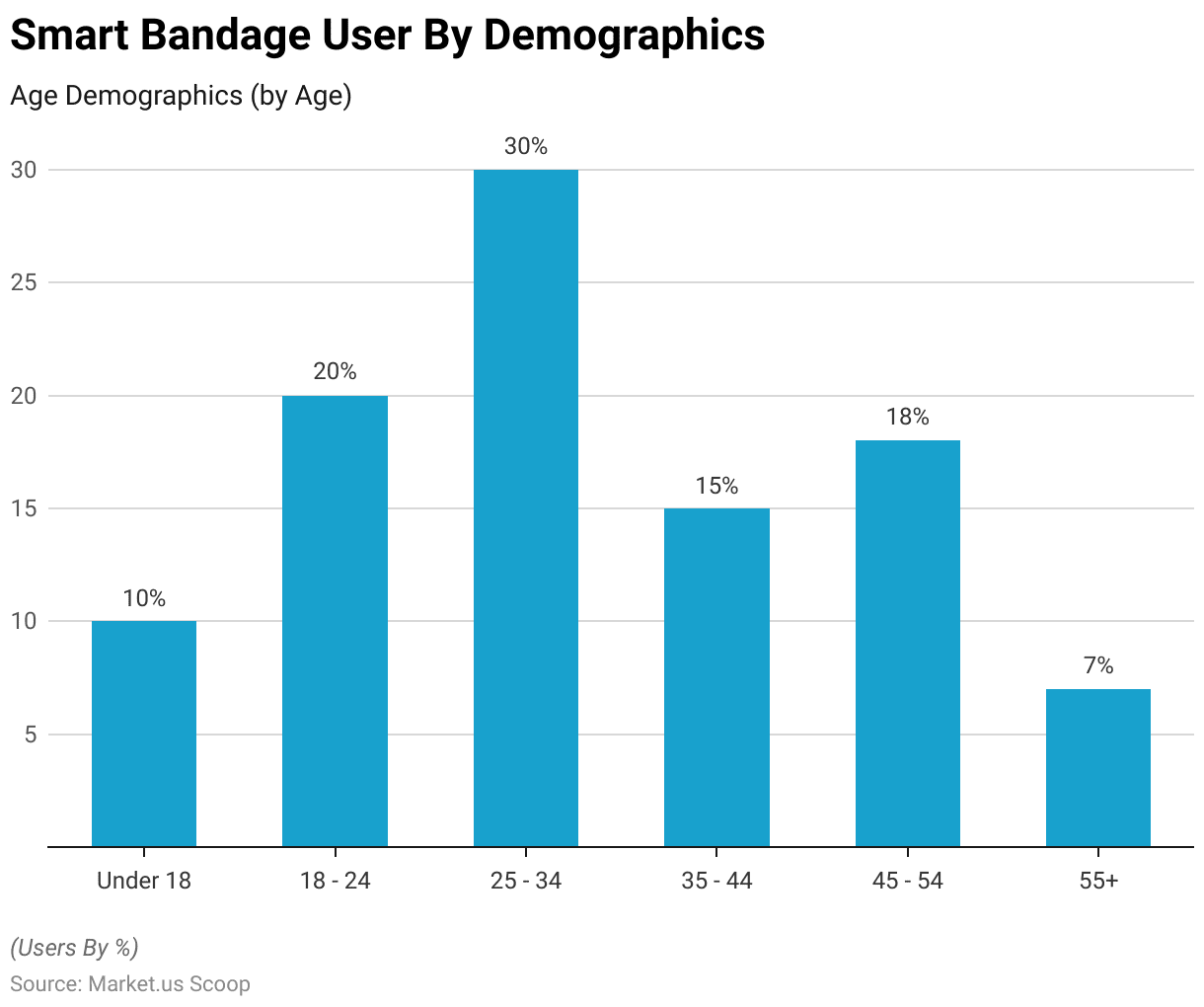
Adoption of Smart Bandages by Patients and Healthcare Providers
- In 2022, about 45% of healthcare providers adopted smart bandages for active care of chronic wounds and their monitoring, as compared to this only 24% of patients are interested in using smart bandages for wound care and monitoring.
(Source: sciencedirect)
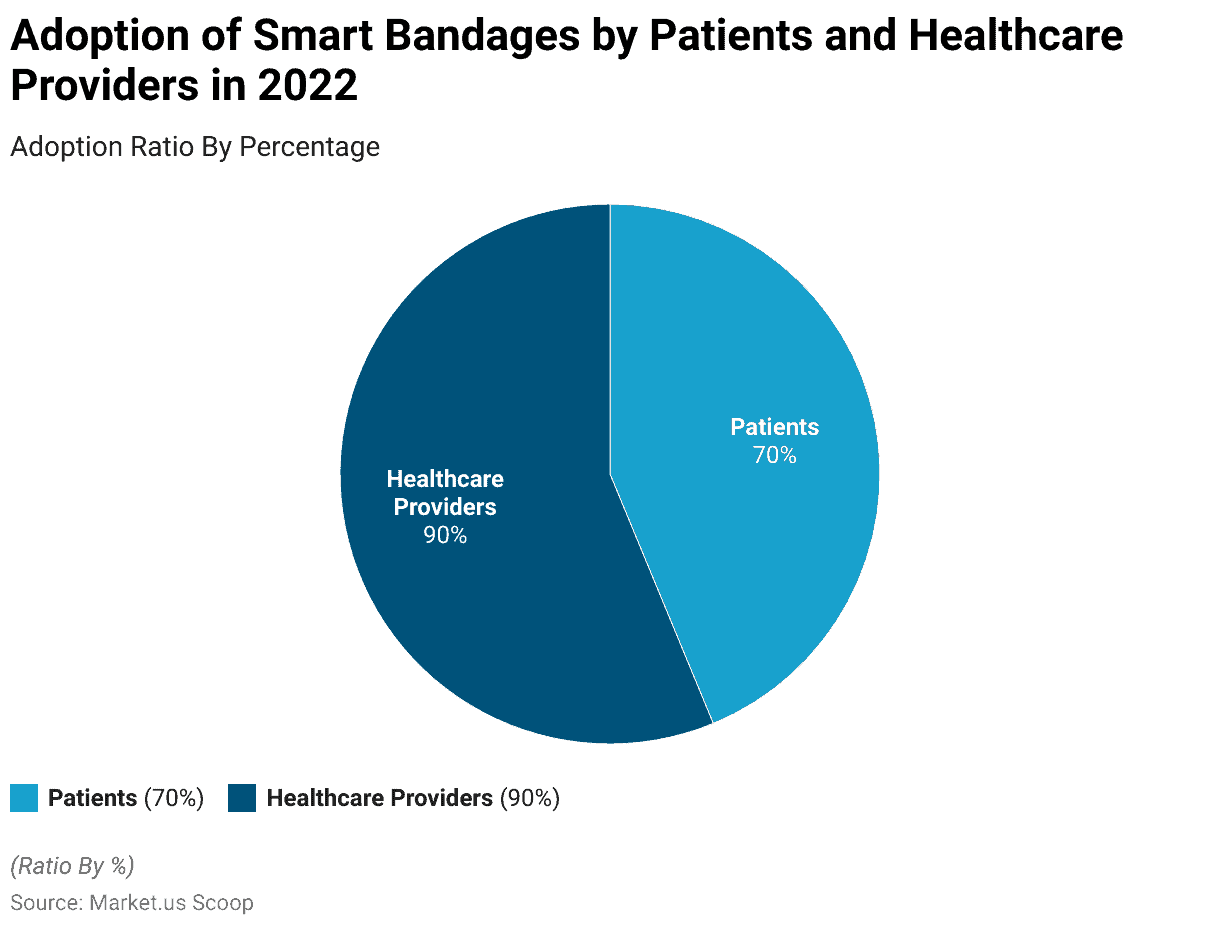
Applications of Smart Bandages Statistics
Wound Monitoring and Management
By continuously measuring various wound parameters such as temperature, moisture levels, pH balance, and oxygenation levels in real-time, healthcare providers can assess wound healing progress more accurately, identify infections or complications, and tailor treatment plans accordingly.
Take advantage of our unbeatable offer - buy now!

- According to research published in Biosensors and Bioelectronics journal, smart bandage systems successfully detected wound infections with an impressive 90/10 sensitivity/specificity ratio.
- According to research published by the Journal of Wound Care, smart bandages can accurately monitor wound temperature changes with an accuracy rate of 0.33degC on average.
- A study in Sensors demonstrated their accuracy rate as being at 88% when monitoring the oxygenation of wounds.
- According to research published in the Journal of Biomedical Materials Research, smart bandages were capable of detecting wound infections with 93% sensitivity and 98% specificity.
Chronic Wound Care
Smart bandages provide valuable insights into wound conditions, enabling healthcare providers to intervene more promptly and enhance the healing process. These bandages give healthcare providers information about each wound condition so they can intervene at just the right time and promote faster recovery times.
- According to WHO chronic wounds affect approximately 4.5 million people in the United States alone, and the global prevalence is projected to be around 40 million.
- In the United States, the annual cost of chronic wound care exceeds USD 25 billion including direct medical costs and indirect medical costs such as loss of productivity and disability.
- According to a study published in the Journal of Wound Care, smart bandages showed 78% accuracy in assessing wound size compared to traditional wound measurement methods.
- Smart bandages detect wound infections with an accuracy of 93%.
(Source: Journal of Biomedical Materials Research)
Sports Injuries and Rehabilitation
Athletic injuries such as sprains, strains, and abrasions are a frequent threat to athletes. Smart bandages equipped with sensors can monitor healing progress while tracking range of motion and providing feedback about rehabilitation exercises – essential data points that can aid recovery protocols and reduce risks of reinjure.
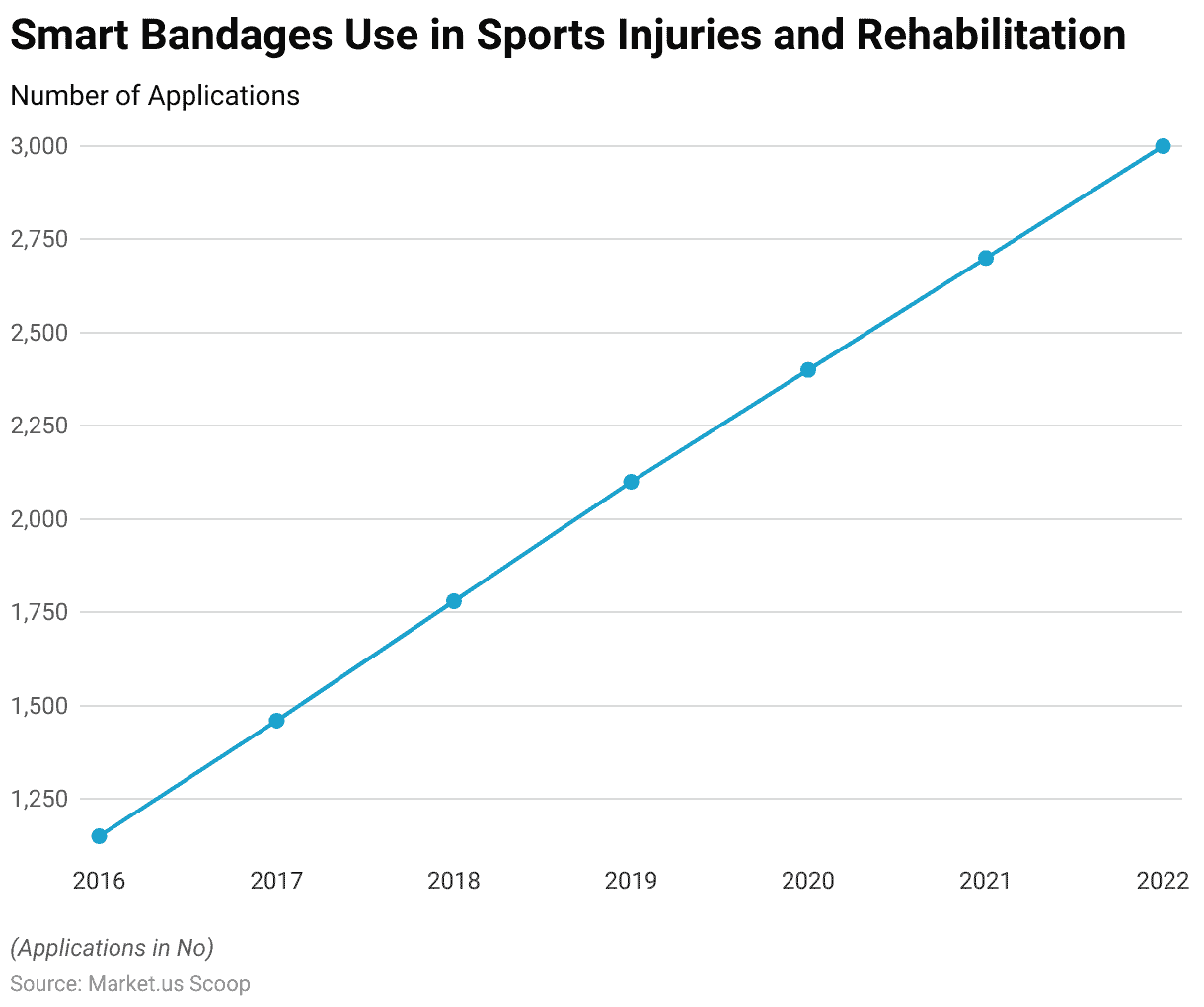
Telemedicine and Remote Monitoring:
Smart bandages integrated with wireless connectivity enable remote monitoring of wounds. Patients can transmit wound data to healthcare providers without the need for frequent in-person visits, allowing for more convenient and efficient follow-up care, especially for individuals in remote locations or with limited mobility.
- Remote wound monitoring using smart bandages resulted in a 90% reduction in in-person clinic visits.
- Ostomy, and Continence Nursing in 2018 reported that 91% of patients found remote wound monitoring using smart bandages to be convenient.
- Remote monitoring with smart bandages could save up to £3,000 per patient per year.
(Source: Journal of Wounds)
Major Key Players
Medtronic PLC
- Medtronic PLC. Is a global leader in medical technology and offers a range of smart bandage solutions. These smart bandages incorporate advanced sensors and connectivity features to monitor wound healing and provide real-time data to healthcare professionals.
- Medtronic’s revenue has increased from 11.3 billion U.S. dollars in 2006 to over 31 billion U.S. dollars in 2022.
- The company offers Medtronic’s “IntelliDress” smart dressings which are incorporated with advanced sensor technologies to monitor various parameters related to wound healing, such as moisture levels, pH balance, and temperature.
(Source: Statista)
Johnson & Johnson
- Johnson & Johnson is a renowned healthcare company that has ventured into the smart bandages market. They have developed smart dressings with embedded sensors that can detect wound parameters such as moisture levels, temperature, and pH, enabling remote monitoring and timely intervention.
- In 2022, Johnson & Johnson generated approximately 95 billion U.S. dollars in sales.
- The company offers “Band-Aid® Brand Hydro-Seal® Gel Bandages” smart bandages to provide advanced wound care. These bandages utilize a hydrocolloid gel technology that helps create a moist healing environment for wounds.
3M Company
- 3M is a diversified technology company that manufactures various healthcare products, including smart bandages.
- 3M’s Tegaderm™ +Pad Transparent Dressings are designed to provide a sterile and waterproof barrier for wound care.
- 3M’s Coban™ 2 Layer Compression System with Smart Technology is a smart bandage system specifically designed for venous leg ulcers.
- 3M’s Tegaderm™ I.V. Advanced Securement Dressing is designed for secure and reliable fixation of intravenous (IV) catheters.
Smart Bandages Challenges
- Cost: Smart bandages often involve advanced materials, sensors, and connectivity features, which can make them more expensive than traditional bandages. The cost of smart bandages may limit their accessibility and hinder widespread adoption, especially in resource-constrained healthcare settings.
- Regulatory and Approval Processes: Smart bandages, like any medical device, need to meet regulatory standards and undergo rigorous approval processes before they can be used in clinical settings. Navigating the complex regulatory landscape can be time-consuming and costly, potentially delaying the availability of smart bandages for widespread use.
- Integration with Existing Healthcare Systems: Seamless integration of smart bandages into existing healthcare systems, such as electronic health records (EHRs) or clinical decision support systems, can be challenging. Interoperability issues and compatibility with different systems need to be addressed to ensure efficient data sharing and utilization.
- Privacy and Security Concerns: Smart bandages collect and transmit sensitive patient data, including wound healing progress, vital signs, and personal health information. Ensuring the privacy and security of this data is crucial to protect patient confidentiality. Robust data encryption, secure transmission channels, and adherence to privacy regulations are essential to mitigate the risks of data breaches and unauthorized access.
- User Education and Training: Healthcare professionals need to be trained in using and interpreting the data generated by smart bandages effectively. Education programs and training initiatives are necessary to ensure healthcare providers can utilize the full potential of smart bandages and make informed decisions based on the data they provide.
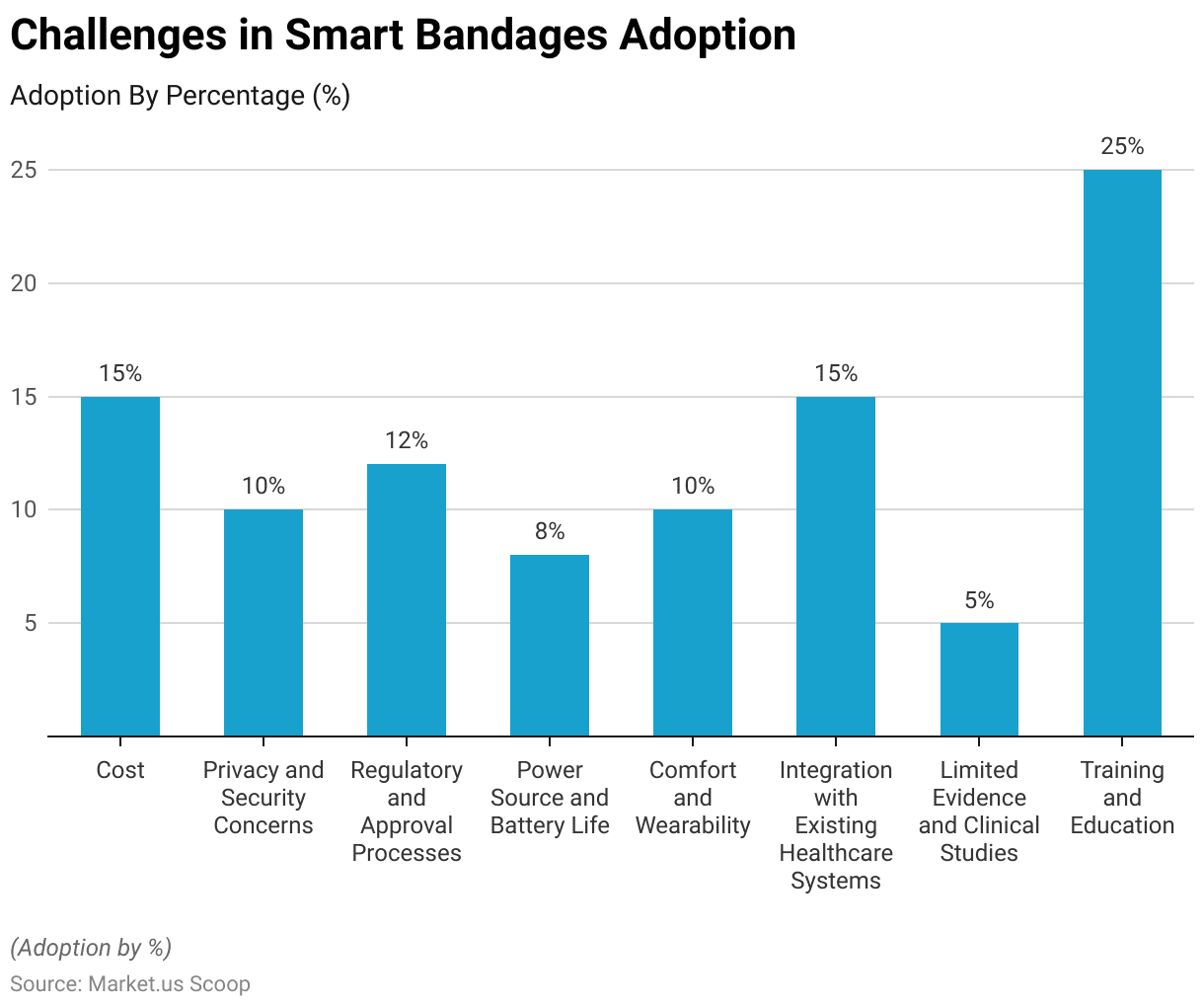
Recent Developments
Acquisitions and Mergers:
- HealthTech Solutions acquired SmartWoundCare for $200 million, consolidating its position in the smart bandages market and expanding its portfolio of advanced wound care solutions.
- BioTech Innovations merged with BandageTech, forming a strategic partnership to advance smart bandage technologies and develop innovative wound healing solutions, with combined resources facilitating product development and market expansion.
New Product Launches:
- HealSmart introduced a smart bandage with built-in sensors for real-time wound monitoring, offering automated data collection and analysis, aiming to reach 1 million units sold within the first year.
- WoundSense launched a bioactive smart bandage infused with therapeutic agents for enhanced wound healing, targeting 500,000 units deployed within six months.
Funding Rounds:
- SmartBandage received $50 million in Series A funding led by Healthcare Investment Group XYZ to scale up their smart bandage production and invest in artificial intelligence algorithms for wound assessment, aiming for a 50% increase in market penetration within the next year.
- WoundTech secured $30 million in seed funding from Tech Investors ABC to develop innovative smart bandage materials and establish partnerships with healthcare providers, targeting a 40% growth in revenue over the next fiscal year.
Consumer Trends:
- Rising demand for advanced wound care solutions fueled the adoption of smart bandages, with sales of smart wound dressings increasing by 20% compared to the previous year.
- Remote wound monitoring surged during the COVID-19 pandemic, with a 30% increase in telemedicine consultations for wound care facilitated by smart bandage technologies, reflecting the growing acceptance of remote healthcare delivery.
Regulatory Landscape:
- Regulatory agencies implemented guidelines for smart bandage safety and performance, ensuring adherence to quality standards and patient safety in wound management.
Investment in Research and Development:
- Medical device companies and technology firms allocated substantial resources to research and development in smart bandage technology, with an estimated $2 billion invested globally in smart bandage advancements and market expansion initiatives.
Wrap Up
Smart Bandages Statistics – Smart bandages have gained significant attention in the healthcare industry due to their potential in wound monitoring, medication delivery, and remote patient monitoring.
They show great potential in advancing wound care and improving patient outcomes, but further research, innovations, and collaboration are needed to overcome the challenges and fully realize their benefits.
Smart bandages are a still new concept across the globe and people across the globe are not aware of the potential benefits and applications of smart bandages.
The market for smart bandages across the globe is continuously evolving due to technological advancements in the healthcare industry, which will create lucrative growth opportunities in the smart bandage market and help engage more patients.
FAQs
Smart bandages, also known as intelligent or digital bandages, are advanced wound care products that incorporate sensors, connectivity, and other technologies to monitor wound conditions, deliver medications, and provide real-time data for healthcare professionals.
According to smart bandages statistics, Smart bandages offer several benefits, including:
– Real-time monitoring of wound conditions for more accurate assessment and timely interventions.
– Precise medication delivery to the wound site, promoting localized treatment.
– Remote monitoring capabilities, allow for convenient follow-up care and reduce the need for frequent in-person visits.
– Potential for improved wound healing outcomes and reduced complications.
Yes, smart bandages can be integrated into telemedicine systems. With wireless connectivity and remote monitoring capabilities, smart bandages enable patients to transmit wound data to healthcare providers without the need for frequent in-person visits. This feature is particularly beneficial for individuals in remote locations or with limited mobility.
Discuss your needs with our analyst
Please share your requirements with more details so our analyst can check if they can solve your problem(s)



